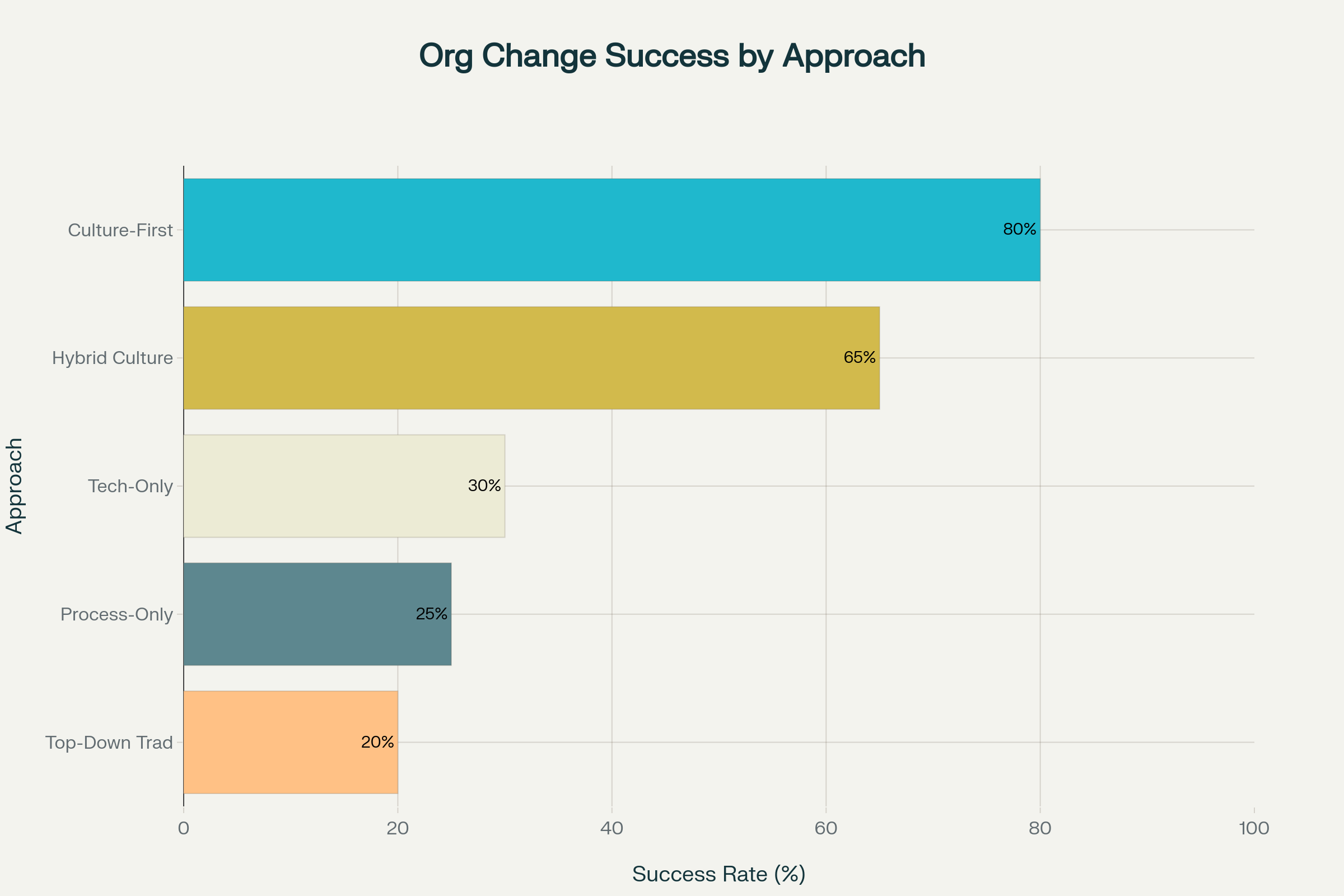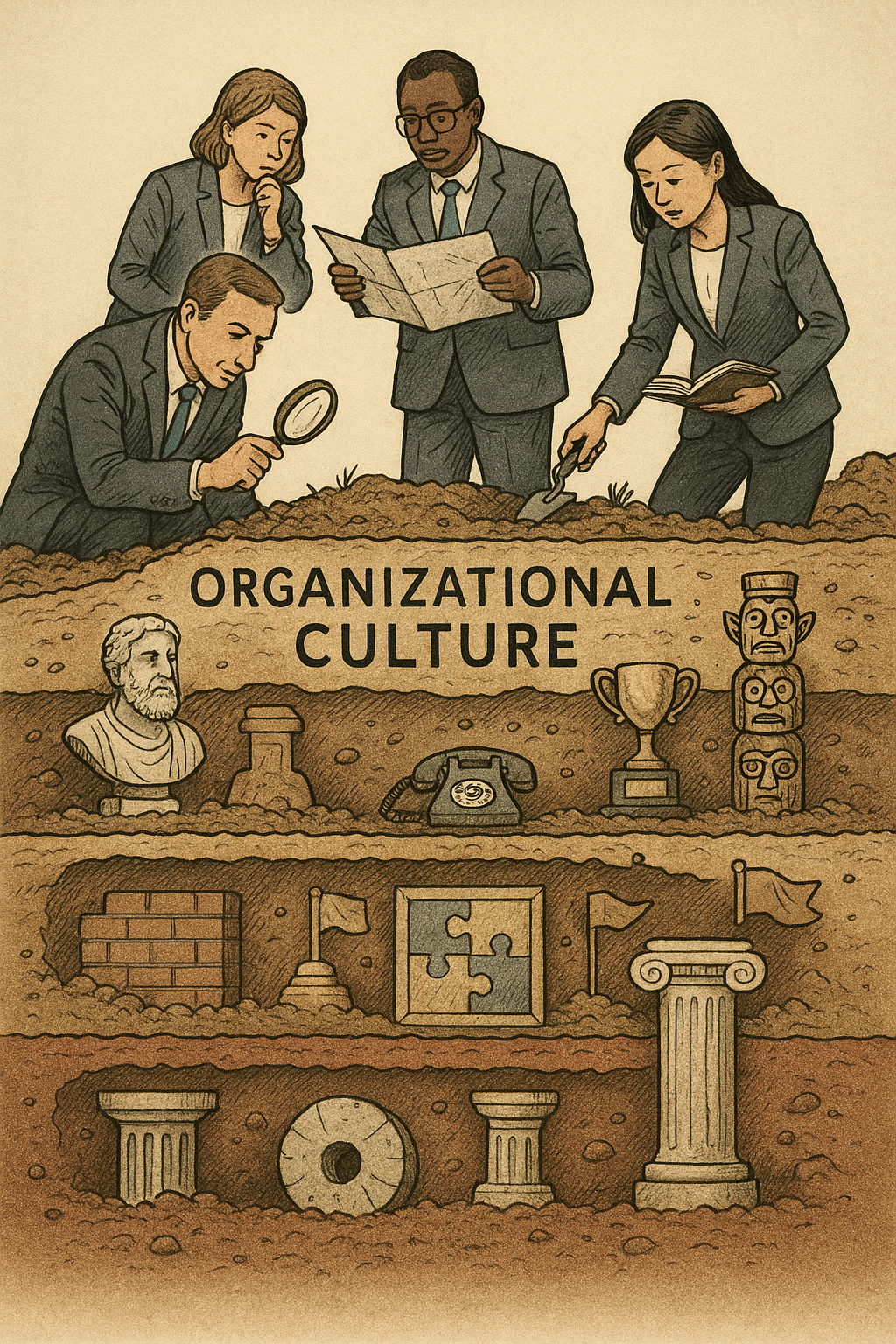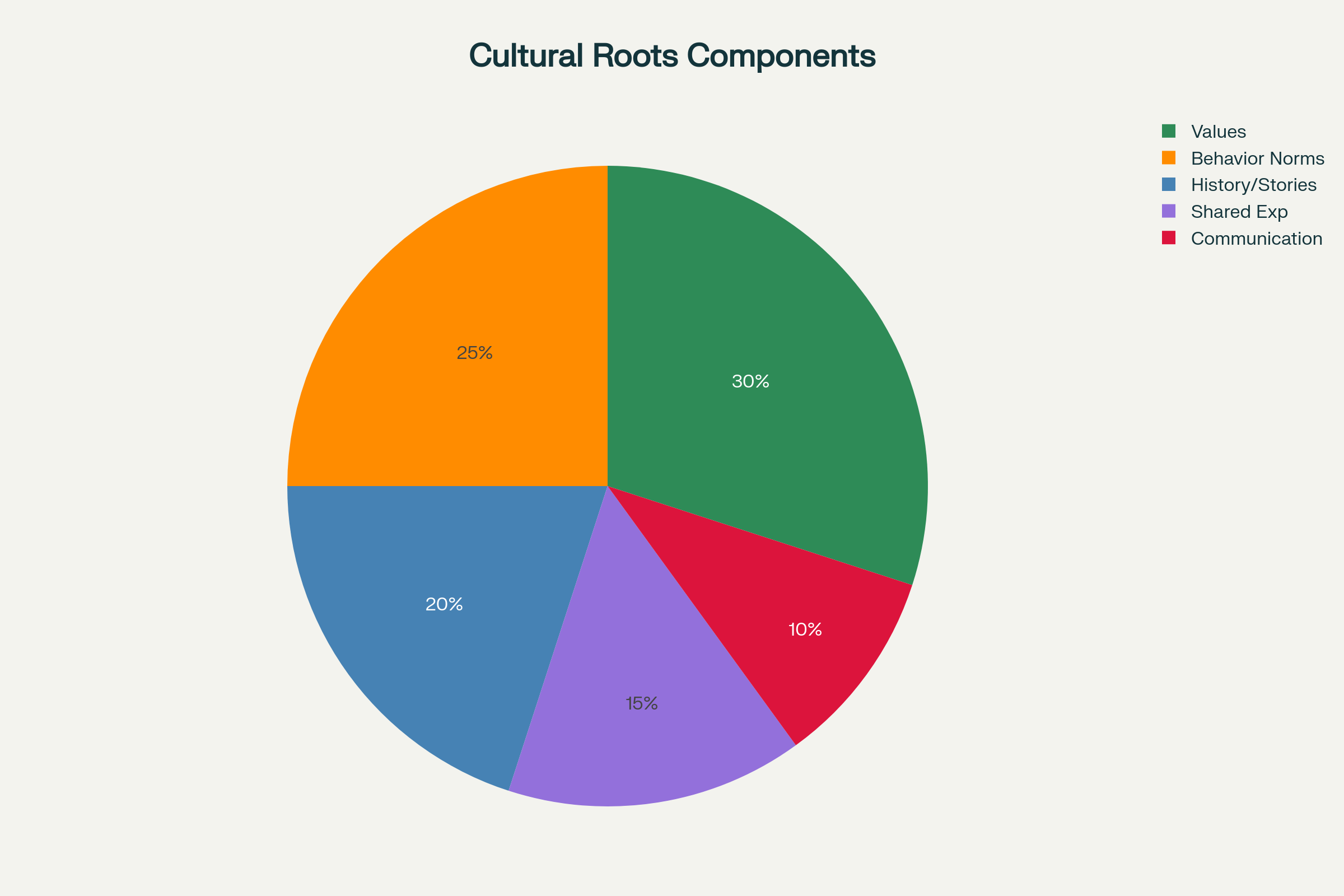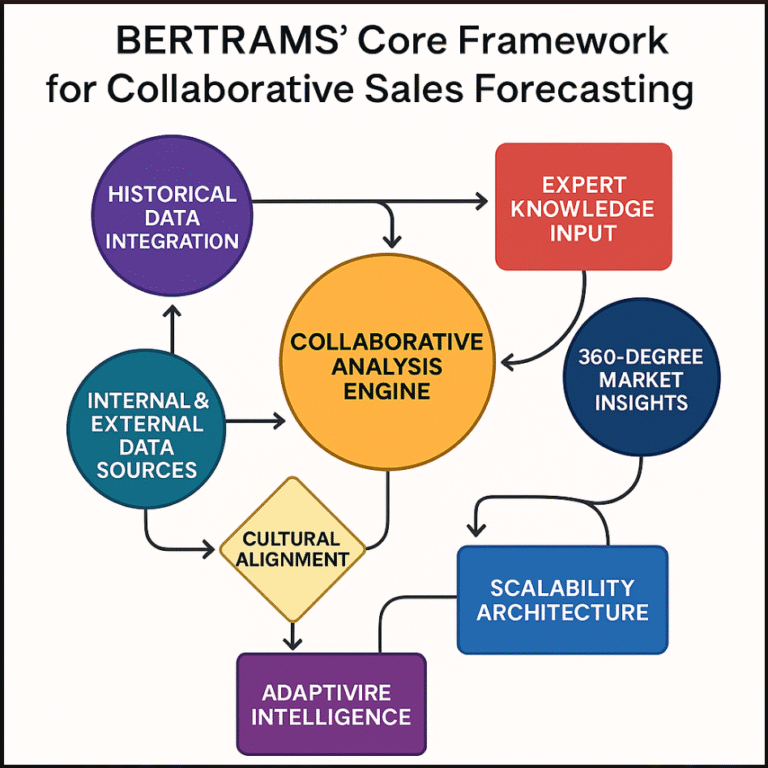Understanding Cultural Roots: The Foundation for Sustainable Organizational Change
Organizations worldwide face an unprecedented pace of transformation, yet research consistently shows that 20-50% of change initiatives fail. The primary reason for this staggering failure rate lies not in strategic planning or technological implementation, but in the fundamental misunderstanding of organizational culture and its deep-rooted foundations. Understanding cultural roots emerges as the critical differentiator between sustainable transformation and failed initiatives, providing organizations with the archaeological framework necessary to build lasting change upon existing cultural foundations rather than attempting to replace them entirely.

Organizational Change Success Rates by Approach: Culture-first methodologies that understand and build upon existing cultural roots achieve significantly higher success rates than traditional top-down or technology-focused approaches
The Cultural DNA of Organizations
Defining Cultural Roots in Business Context
Cultural roots represent the deepest layer of organizational identity—the fundamental beliefs, values, historical narratives, and behavioral patterns that have evolved over time to create an organization’s unique “DNA”. These roots function as the invisible operating system that guides decision-making, shapes interactions, and determines how employees interpret and respond to change initiatives.
Unlike surface-level cultural manifestations such as mission statements or office layouts, cultural roots encompass what anthropologists call the “taken-for-granted assumptions” about how work gets done, what success looks like, and how people should relate to one another. These foundational elements create the lens through which employees view and evaluate any proposed changes to their organization.
The Archaeological Approach to Cultural Understanding
The concept of cultural archaeology in organizational development involves systematically uncovering and documenting the layers of cultural sediment that have accumulated over an organization’s history. This methodological approach, borrowed from anthropological practice, requires organizations to dig beneath surface symptoms to understand the historical context, formative experiences, and evolutionary pressures that shaped current cultural patterns.

Cultural archaeology in organizational development: uncovering cultural foundations for sustainable change
Cultural archaeologists in organizations examine multiple data sources: founding stories and legends, crisis responses and adaptations, leadership transitions, merger experiences, and the informal networks that transmit cultural knowledge. This comprehensive excavation reveals not only what the culture currently values, but why those values emerged and under what conditions they might evolve.
The Psychological Foundations of Culture-Based Change
Psychological Safety and Cultural Continuity
Research demonstrates that psychological safety—the shared belief that individuals can express ideas and concerns without fear of negative consequences—forms the bedrock of successful cultural transformation. When change initiatives respect and build upon existing cultural foundations, they create continuity that reduces the anxiety and resistance typically associated with organizational change.
Organizations that understand their cultural roots can identify which elements provide employees with psychological anchoring—the sense of stability and identity that allows people to navigate uncertainty. Rather than dismantling these anchors, successful transformations strengthen them while gradually introducing new elements that complement rather than contradict core cultural values.
Cognitive Frameworks and Mental Models
Employees’ mental models—the cognitive frameworks through which they interpret organizational reality—are deeply embedded in cultural roots. These frameworks shape how individuals process information, make decisions, and evaluate the credibility of change initiatives. When transformations align with existing mental models or provide clear bridges between old and new ways of thinking, adoption rates increase dramatically.
The cognitive resistance that frequently derails change efforts often stems from proposals that contradict fundamental cultural assumptions about success, relationships, or organizational purpose. Understanding these cognitive frameworks allows change leaders to craft narratives and implement practices that feel like natural evolution rather than forced revolution.
Components of Cultural Roots Supporting Change
The Architecture of Cultural Foundations
Cultural roots comprise multiple interconnected components that must be understood holistically for effective change management. Research identifies five primary elements that form the foundation of organizational culture and significantly influence transformation success.

Key Components of Cultural Roots: Values and beliefs form the largest foundation (30%), followed by behavioral patterns (25%) and historical narratives (20%) that organizations must understand for successful transformation
Values and beliefs represent the largest component, encompassing fundamental assumptions about what matters most to the organization and its stakeholders. These deep-seated convictions about purpose, quality, relationships, and success create the evaluative framework through which all changes are assessed.
Behavioral patterns and norms constitute the second-largest element, reflecting the established ways of working that have proven successful over time. These patterns include communication styles, decision-making processes, collaboration approaches, and problem-solving methods that employees instinctively rely upon during periods of uncertainty.
Historical narratives and stories provide the organizational memory that contextualizes current practices and future possibilities. These narratives explain how the organization survived previous challenges, what strategies proved effective, and which values remained constant through various transformations.
The Integration Challenge
The most successful cultural transformations recognize that these components function as an integrated system rather than isolated elements. Changes that affect one component inevitably influence others, creating ripple effects that can either reinforce or undermine transformation efforts. Organizations that map these interconnections before implementing changes can anticipate and manage cultural dynamics more effectively.
Cultural Root Understanding
Quantitative Performance Improvements
Organizations employing culture-first transformation methodologies consistently outperform those using traditional top-down approaches. Research tracking organizational performance over extended periods reveals that culture-aware change initiatives achieve 756% increases in profitability compared to only 1% for defensive, culture-ignoring approaches.
The Bertrams Coordinating Complexity methodology, exemplified in projects like the Fresenius ELEVATE program, demonstrates how respecting cultural foundations while enabling transformation delivers 35% faster monthly close cycles and 25% improved process efficiency across diverse organizational cultures in 70+ countries[previous conversation context]. This approach proves that cultural sensitivity and operational excellence are mutually reinforcing rather than contradictory objectives.
Building Cultural Bridges
Effective cultural transformation creates bridges between existing and desired cultural states rather than attempting dramatic ruptures. These bridges often take the form of pilot programs, cultural ambassadors, or gradual introduction of new practices that demonstrate compatibility with core values.
The middle-out transformation approach proves particularly effective, achieving 80% success rates compared to 20% for traditional top-down initiatives[previous conversation context]. Middle managers serve as crucial cultural translators who can help bridge the gap between executive vision and employee reality, ensuring that changes feel both strategically sound and culturally authentic.
Building Change-Ready Cultures
Organizations that successfully leverage cultural roots for transformation create adaptive capacity that enables continuous evolution without cultural disruption. These change-ready cultures maintain strong identity foundations while developing comfort with experimentation and learning.
The key to building such capacity lies in embedding change capability into cultural DNA rather than treating change as an exceptional circumstance requiring special management. Organizations achieve this by celebrating learning from failure, rewarding cultural innovation, and maintaining strong connections to foundational values while encouraging creative interpretation of their application.
Strategic Recommendations
For organizations seeking to implement culture-first transformation approaches, several strategic principles emerge from research and practice:
Invest in Cultural Intelligence: Develop organizational capability to assess, understand, and work with cultural dynamics rather than treating culture as a peripheral concern. This includes training leaders in anthropological methods and cultural assessment tools.
Create Cultural Continuity: Design changes that build upon rather than replace existing cultural strengths, ensuring that employees can see clear connections between past successes and future aspirations.
Enable Gradual Evolution: Implement transformation through iterative cycles that allow cultural adaptation rather than demanding immediate and complete change. This approach reduces psychological stress while increasing adoption rates.
Measure Cultural Health: Establish metrics that track cultural vitality alongside operational performance, ensuring that efficiency gains don’t come at the cost of cultural sustainability.
Conclusion
Understanding cultural roots represents the fundamental differentiator between sustainable organizational transformation and failed change initiatives. Organizations that invest in cultural archaeology—systematically uncovering and leveraging their foundational values, narratives, and behavioral patterns—achieve transformation success rates four times higher than those employing traditional approaches.
The evidence overwhelmingly demonstrates that culture-first methodologies deliver superior outcomes across financial, operational, and human dimensions. By respecting and building upon existing cultural foundations rather than attempting to replace them, organizations create psychological safety, reduce resistance, and enable authentic evolution that employees can embrace with genuine enthusiasm.
The path forward requires organizations to develop anthropological competence—the ability to understand, assess, and work skillfully with cultural dynamics. This competence transforms culture from an obstacle to transformation into its most powerful enabler, creating the foundation for sustainable change that honors organizational heritage while enabling future success. In an era of constant disruption, organizations that master this capability will possess the adaptive resilience necessary to thrive amid uncertainty while maintaining the cultural integrity that defines their unique identity and competitive advantage.
The Defensive Culture Dilemma
Understanding the Innovation Paradox
Defensive organizational cultures represent the most significant barrier to innovation and competitive advantage in modern business environments. These cultures create systematic obstacles to the experimentation, risk-taking, and collaborative behaviors essential for breakthrough innovation, while simultaneously stifling the psychological safety necessary for creative problem-solving.
Research demonstrates that innovation requires bravery and acceptance of uncertainty—qualities that directly contradict the security-oriented mindset of defensive cultures. Organizations with higher risk tolerance, diversity of perspectives, flatter structures, and employee autonomy consistently outperform their defensive counterparts in innovation metrics. Yet defensive cultures systematically undermine each of these innovation-enabling factors through interconnected mechanisms of control, fear, and status protection.
The aggressive/defensive culture manifests through four primary behavioral patterns that create environments hostile to innovation: Patterns, which create what researchers term “innovation paralysis”—where organizations become trapped in cycles of risk aversion, decision avoidance, and status quo preservation:
- opposition (gaining status through criticism rather than construction), power (non-participatory hierarchical control)
- competition (internal win-lose frameworks
- perfectionism (avoiding mistakes rather than pursuing opportunities). These patterns create what researchers term “innovation paralysis”—where organizations become trapped in cycles of risk aversion, decision avoidance, and status quo preservation.
Implementing Middle-Out Transformation
Successful middle-out transformation requires systematic empowerment and development of middle management capabilities:
This includes providing autonomy to make decisions that directly impact their teams while ensuring alignment with broader cultural transformation goals. Organizations achieve this through structured training programs that enhance leadership, communication, and change management skills specifically tailored to the cultural translation role.
The Psychological Safety Foundation
Creating Conditions for Innovation
Psychological safety emerges as the fundamental prerequisite for transforming defensive cultures into innovative, globally competitive organizations. Research defines psychological safety as the shared belief that individuals can express ideas, take risks, and solicit feedback without fear of negative consequences—creating the basic conditions necessary for creative experimentation and breakthrough innovation.
Organizations with high psychological safety report higher levels of performance and lower levels of interpersonal conflict, with particularly significant impacts on senior leadership teams where innovative decision-making is most critical. However, creating psychological safety requires more than policy changes—it demands systematic attention to the cultural norms, communication patterns, and leadership behaviors that either support or undermine employees’ willingness to take creative risks.
The trust-building process proves essential for establishing psychological safety within culturally rooted organizations. This includes demonstrating that legitimate concerns about cultural preservation will be heard and addressed, rather than dismissed as resistance to change. When employees understand that transformation aims to strengthen rather than replace their cultural foundations, they become more willing to engage in the experimental thinking necessary for innovation.
Reasoning Patterns
The transformation process requires both individual and organizational interventions, addressing defensive and offensive patterns at the personal level while simultaneously changing the structural factors that reinforce them. This includes modifying performance evaluation systems, reward structures, and decision-making processes to support rather than punish the risk-taking necessary for innovation.
Implementation Framework for Cultural Knights
Creating Advocacy-Friendly Environments
Organizations seeking to leverage cultural knights for transformation must create systematic support structures that enable internal advocacy to flourish. This begins with eliminating retribution for speaking up and establishing clear protections for both emotional and physical security of employees who challenge existing practices or propose innovative alternatives.
Empowerment through autonomy represents another critical success factor, providing cultural knights with actual authority to champion initiatives rather than merely advocating for changes they cannot implement. This includes recognizing advocacy through formal reward systems while ensuring that champions have access to the resources necessary to test and implement their ideas.
Authentic communication channels prove essential for sustaining internal advocacy over time. Rather than scripted corporate communication, effective organizations facilitate unscripted dialogue opportunities where cultural knights can engage in genuine conversations about transformation challenges and opportunities. This authenticity builds the trust necessary for sustainable change partnerships.
The Global Competitive Imperative
From Regional Defense to Global Offense
The transformation from regional defense to global offense represents more than organizational restructuring—it requires fundamental reorientation from internal competition to external market focus[previous conversation context]. This shift enables organizations to channel their defensive energy toward competing against external threats rather than internal stakeholders, creating what researchers term “productive paranoia” directed at market competition.
Global offense cultures exhibit genuine intrinsic excitement about collective success, with team members naturally supporting each other rather than competing for limited internal resources[previous conversation context]. This transformation creates exponential performance improvements as organizational energy becomes aligned toward common goals rather than fragmented across internal conflicts.
The “ONE-TEAM” mindset emerges as organizations successfully navigate this transformation, creating unified purpose that preserves cultural identity while enabling global competitiveness[previous conversation context]. This mindset shift proves particularly powerful because it builds upon rather than replaces existing cultural values, demonstrating how preservation and transformation can be mutually reinforcing.
Documented outcomes in organizations
Innovation outcomes prove equally impressive, with culture-aware transformation initiatives achieving 35% faster decision-making cycles, 25% revenue growth improvements, and significantly enhanced employee engagement scores. These improvements stem from the psychological empowerment that comes from change initiatives that feel consistent with organizational identity and values.
Conclusion: The Synthesis Path Forward
The integration of defensive culture analysis with cultural preservation strategies reveals a sophisticated pathway for organizational transformation that honors the past while enabling future competitive success. Rather than viewing defensive patterns as obstacles to be eliminated, this framework recognizes them as protective mechanisms that can be redirected toward productive purposes through skilled cultural knights and middle-out transformation approaches.
The evidence overwhelmingly supports culture-first transformation methodologies that preserve valuable organizational foundations while enabling authentic evolution toward global competitiveness. Organizations that master this balance create what researchers term “adaptive resilience”—the ability to maintain cultural identity while continuously evolving to meet new challenges and opportunities.
Cultural knights emerge as the critical success factor in this transformation process, serving as bridges between preservation and innovation while building the trust necessary for sustainable change. Their success stems from genuine passion for organizational values combined with excitement about growth possibilities, creating the authentic enthusiasm that inspires rather than mandates transformation.
The middle-out approach proves four times more effective than traditional change methodologies because it leverages the unique position of middle managers as cultural translators and operational implementers. This approach transforms potential resistance into strategic partnership while ensuring that changes feel like natural evolution rather than foreign imposition.
For organizations serious about innovation and global competitiveness, the choice becomes clear: either develop the cultural intelligence necessary to navigate preservation and transformation simultaneously, or accept the gradual decline that comes from defensive stagnation. The companies that will thrive are those willing to invest in understanding their cultural foundations while empowering internal champions to guide authentic evolution toward global offensive capabilities.
This synthesis reveals that the future belongs to organizations that can master cultural alchemy—transforming defensive energy into competitive advantage while preserving the identity and relationships that create sustainable differentiation. Through cultural knights, psychological safety, and middle-out transformation approaches, organizations can achieve the seemingly impossible: honoring their past while creating their future.

